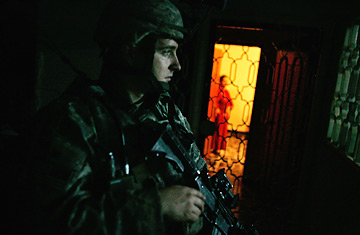
U.S. Army Sergeant Jonathan Schill of 82nd Airborne Division takes up a position during a raid on a home in Baghdad.
It is a measure of how warped things have become in Iraq these days that attacks on nearly a dozen mosques over three days qualifies as good news. That's because it could have been so much worse in the wake of this week's bombing of the Shi'ite Askari mosque in Samarra.
When the same shrine was bombed in February 2006, more than 100 Sunni mosques were damaged or destroyed by rampaging Shi'ite mobs in the weeks that followed, and thousands of people from both communities were killed in tit-for-tat attacks. The locus of this violence was Baghdad, the stronghold of Moqtada al-Sadr's Shi'ite militia known as the Mahdi Army. When the carnage began, American troops in and around the Iraqi capital had been mostly in what the military calls "force protection" mode. They were largely confined to their bases and doing relatively little patrolling, instead counting on the newly formed Iraqi Army and police to keep the peace. But Iraqi security forces could only look helplessly on — and in some instances join in — as the Mahdi Army began a systematic campaign of sectarian cleansing from mixed neighborhoods.
Following the latest bombing of the shrine, there has been remarkably little retaliation, apart from scattered acts of violence against a handful of Sunni mosques. It has helped that Shi'ite leaders were quick to call for restraint. Al-Sadr asked his followers to observe three days of mourning and peaceful demonstrations. The Iraqi Shi'ites' most revered figure, Grand Ayatollah Ali Sistani, said Sunnis should not be harmed. But such calls have gone unheeded in the past — Sistani had appealed for calm after the first Samarra bombing, too.
If appeals for restraint are working now, it's because they're backed up by the force of American arms.
Luckily for Baghdadis, the second Samarra attack came just as the last battalions participating the American "surge" arrived in Baghdad. Nearly 28,000 additional U.S. soldiers have been sent to Iraq, and the majority of them are deployed in an aggressive posture across the city, backed (albeit feebly) by over 50,000 Iraqi soldiers and police.
When the surge began in February, al-Sadr ordered his fighters not to confront the Americans. Since then, Sunni jihadi groups have tried repeatedly to provoke the militias to come out and fight, sending suicide bombers into several Shi'ite neighborhoods. Analysts here worried that an attack on a major Shi'ite religious figure or site might send the Mahdi Army over the edge — and the second bombing of the Samara mosque was designed to do just that.
But if the surge has done little to curb the terrorist attacks of Sunni extremist groups like al-Qaeda, which is blamed for both Samarrra bombings, it seems to have had a dampening effect on Shi'ite rage. Few Mahdi Army fighters have the stomach for confrontation with the Americans. They have not forgotten that the last time they went toe-toe with the U.S. military — in Najaf in 2004 — they were thoroughly and easily beaten.
Still, don't count the militias out: a few more egregious acts of provocation from al-Qaeda, and the Mahdi Army could come back into the fray. But for the moment, the surge is keeping a lid on a sectarian free-for-all. Residents of Baghdad often blame their many problems — everything from electricity shortages and soaring gas prices to unemployment and government corruption — on the Americans. Just this once, they might be inclined to give thanks.
